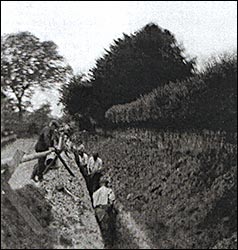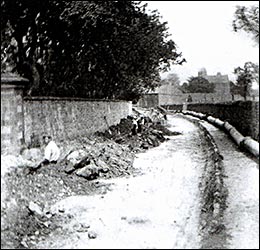|
Town meetings were held at Rushden and Higham Ferrers in the middle of December, 1901. The one for Rushden was held in the Public Hall in Coffee Tavern Lane, and Higham’s was held in the Town Hall. Surprisingly, neither attracted a large attendance.
At the meeting in Rushden, Mr G Denton outlined the steps that had already been taken over many years to secure a supply of water, and the failure to identify such a source that would keep pace with demand. The growth of the town depended on locating a permanent, adequate supply. The Sywell scheme had been originated by a private Company two years earlier and which provided for the damming of the brook near Sywell and impounding the water. The engineer who had been engaged by that Company had reported its practicality when the Bill was before Parliament, but the Company had failed to get customers for its water and it had not been possible to take up the scheme until now with Rushden associating with Higham Ferrers to promote a Bill to acquire the Company’s powers. A slight addition to the Rates of 3d or 4d (or possibly 6d) extra in the pound was envisaged for the first few years, but the benefits would be overwhelming. Revenue from water at that time was £17,000 but with an abundant supply this would be considerably increased. A new reservoir would be built on Bedford Road, about 40 feet higher than the one at Wymington, as it had become evident that the old reservoir was not high enough to supply all parts of the town, particularly places on the Wellingborough side. The resolution was carried unanimously.
The meeting at Higham Ferrers heard from the Mayor, Mr Owen Parker, who traced the history of the efforts of that Council during the previous five years to improve the water supply to the borough. One scheme after another had failed to provide the necessary quantity of water, but when the Council was approached in 1898 by a private Company for the purpose of getting a Bill through Parliament the Council had supported that Bill – The Nene Valley Bill – and it had also been supported by Finedon and other authorities. However, opposition from around Thrapston was so resolute that the Bill failed to gain the assent of Parliament. Then, in 1899, another Company had approached the Council with a proposal to supply another area from another source. The Council gave their cautious assent to this Company and supported the scheme, but the reluctance of other local authorities to join the scheme and obtain their water from that source meant that Bill had to be abandoned. It was therefore to the advantage of the residents of the borough that Rushden were seeking to be included in the Act and proposed the formation of the Higham Ferrers and Rushden Water Board. The Board would be a public body, unlike the Gas Company which was a private company, and would take over the existing undertaking at Rushden. It was likely that the supply could be extended to neighbouring villages – but not until they had secured a supply of 25 gallons per head for Rushden and Higham. The resolution was carried ‘nem con’ as Alderman Spong did not vote.
The proposal in the Act was to impound water flowing off an area of over 2,000 acres of land in the parishes of Sywell and Mears Ashby. The water flowed off in two main streams, one rising in Sywell village and the other in Sywell Wood, and which joined at a point where Sywell Mill stood. On the 1886 Ordnance Survey map an uninhabited cottage and gardens were on this site with the mill which had been operating on the Sywell Bottom Brook for nearly 600 years. The mill was apparently held by the Prior of St Andrews of Northampton in 1291, and was mentioned in the Royal Directory of 1866, which recorded that John Martin was the miller. The mill probably stopped working in 1886. Washing sheep was another activity that took place in the brooks with references dating back to 1777.
Despite the enthusiasm of both Councils, 1902 had barely begun before it was evident that the Higham Ferrers and Rushden Water Bill would encounter some strong opposition on its way through the legal stages and formalities. The Wellingborough Rural Council, the Bedford Rural Council and County Council, the Northamptonshire County Council, together with the various parishes which would be affected by the Bill, were closely watching their interests.
The area required for the works amounted to just over 133 acres and included land from three estates: Ecton, Overstone and Mears Ashby. The Act of Parliament would allow compulsory purchase of the land. Local people were worried that the reservoir would take their natural water, and there were also worries that fishing and shooting activities would be lost.
The work proposed to build an embankment about 90 feet high across the valley about 200 yards south of the old mill and form a vast lake covering around 40 acres. In order that there should be no possibility of sewerage contamination from Sywell, the sewerage would be diverted by pipes so as to discharge into the brook below the reservoir. The capacity of the reservoir was calculated to be 130 million gallons which would allow storage for 260 days at 500,000 gallons per day. The rising main would be carried from Sywell and Mears Ashby through Earls Barton, Great Doddington, Wollaston, Farndish, Podington and Wymington to the storage reservoir at Rushden. The pipe would follow the line of the roadway for the entire length of this route, (except for two instances between Wollaston and Farndish where it crossed private land), a distance of about 11 miles.
Certain concessions were negotiated between the Board and some of the parishes and Councils so that, despite their initial cautiousness, one by one the various authorities approved the scheme – with the exception of Mears Ashby, Ecton and Sywell. These parishes asked that they should be supplied with water free of charge, a request that the promoters did not entertain for one moment. However, they proposed that these parishes should have equal rights with Rushden and Higham Ferrers and therefore not depend for their supply upon surplus water (which the other parishes were willing to do) but make use of the scheme in the same way s Rushden and Higham. During January, the Public Health Committee of Northamptonshire County Council held an enquiry into the matter and, after having met with representatives from the various involved parties, refused to support the claims of the three parishes and unanimously recommended the County Council not to oppose the Bill.
The Company was authorised by the Act to raise capital of £72,000, divided into 14,400 shares of £5 each, with power to borrow a maximum sum of £24,000, (the borrowing power being limited to a third of the subscribed capital for the time being), making a total capital of £96,000, which could not be exceeded without obtaining a fresh Act of Parliament for the purpose.
On 12th March 1902, the Rushden and Higham Ferrers Water Bill was considered in committee at the House of Commons. The clauses added to the Bill, to meet the objections and requirements of the Northamptonshire County Council, the Wellingborough Rural District Council, the Bedfordshire County and Rural District Councils, the Midland Railway, the London and North-Western Railway, and the Nene Valley Navigation Commissioners, were passed without question. A somewhat lengthy discussion took place over a large number of amendments suggested by the Local Government Board. So far as they did not affect the main principle of the Bill, or materially limit its working, the promoters accepted them, however, the objections raised by the Local Government Board, especially those dealing with the financial proposals in the Bill, were contested. The Local Board’s objection as to the period to be allowed for the repayment of the loans was overruled and the 60 years provided by the Bill allowed to stand, although for a comparatively small amount for extras, improvements and working expenses, the period of repayment was reduced to 40 years. The Bill then passed through all its stages in the House of Commons.
By the middle of April the Water Bill had advanced another stage when it came before the Examiners of the House of Commons for proof of compliance with the further orders. As no opposition was offered, and the necessary formal proofs having been given, the Bill was passed for the second reading in the Lords. This took place at the beginning of May as an unopposed measure and was ordered to be reported to the House for its third reading.
 |
 |
|
Pipe Laying at Farndish
|
|